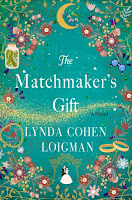Author: Lynda Cohen Loigman
Publication Information: St. Martin's Press. 2022. 320 pages.
ISBN: 1250278090 / 1250278090
Rating: ★★★★
Book Source: I received this book through NetGalley free of cost in exchange for an honest review.
Opening Sentence: "Sara was ten years old when she made her first match."
Favorite Quote: "There is too much cruelty in this world. I've seen it and I know you've seen some, too. It isn't enough to fight against cruelty. For my whole life, I fought for love. Not just romantic love, you understand. The love of a parent for a child. The love of one friend for another. Fight for something, sweetheart. Not just against. That's the best advice I can give you. And if you can't decide what you want to fight for, love is as good a cause as any."
A shadchan is a male Jewish matchmaker. A shadchanit is a female matchmaker except that there were not many - if any - of them in the early 1900s on the Lower East side. Making matches was a career for many and could be big business depending on the wealth of the client. For example, almost 2,000 guests were invited to the actual wedding of the daughter of the New York "pickle millionaire" in 1909. The matchmaking was an inherent part of the orthodox Jewish culture of the Lower East side, deeply imbedded in the immigrant community that lived and thrived in the neighborhood.
This is the historical world where the story of Sara Glikman is imagined. She is a first generation immigrant to the United States. Sara has a gift that she discovers at age 10 on that ocean voyage. She is able to see connections between individuals and can identify the perfect matches. However, she is ten and a girl. She buries that instance. However, throughout her life, the gift resurfaces. Sara never monetizes her gift; hence, she does not consider herself a matchmaker. When family events bring financial hardship, she comes out of the shadows and claims her profession. If female matchmakers even existed, they certainly were not young, unattached, and potentially eligible themselves. Sara's decision to be a matchmaker reverberates throughout the community. Throughout it all, Sara keeps records of her matches.
Therein lies the connection to the other side of the story line. Abby is Sara's granddaughter. When Sara dies, Abby inherits her journals. At first, she does not know what to make of them. As she slowly discovers Sara's gift and her history, the question arises. Why leave the journals to Abby? Given the nature of the book, the answer to that question is pretty clear. Abby's journey to learn about Sara becomes a journey of self-discovery as well.
The story goes back between the perspectives of the two women. I do have to suspend disbelief on the ability of an individual to see matches, or perhaps it is more engaging to believe in the idea of soulmates and the idea that soulmates can be clearly identified. As with many two timeline story, one - Sara's - is more compelling than the other. Both are interesting, but Sara's story with its history and its picture of a time and place is the one I will remember.
Please share your thoughts and leave a comment. I would love to "talk" to you.

No comments:
Post a Comment